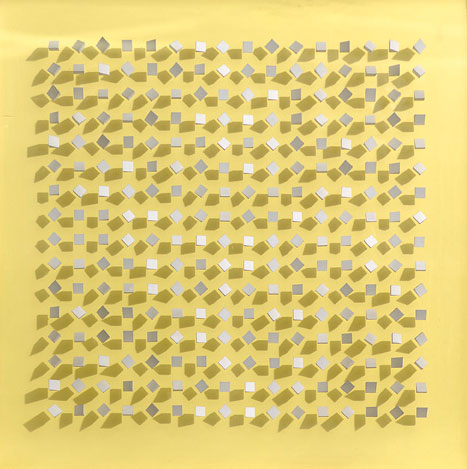Klaus Staudt
Periphere Verdichtung, 1965/67
[Peripheral Aggregation]
Wood, Perspex, white and yellow emulsion
70 x 70 x 9,5 cm
© VG Bild-Kunst, Bonn 2022
Photo: Gerhard Sauer
Klaus Staudt's work stands fully in the tradition of constructive-concrete art. The artist has developed the underlying ideas, which hail back to the beginning of the last century, in his own unique way and arrived at solutions in the geometrical abstract style that are unmistakably his own and have great aesthetic power. At the commencement of his artistic career, a decisive influence on his work and development was exerted not only by his colleagues in Munich, but above all by the ZERO group and the GRAV group (Groupe de Recherche d'Art Visuel) founded 1960 in France. Like the members of the GRAV, Staudt also pursued his own methodological approaches based on mathematical laws and systematic combination. And like so many representatives of mathematical-constructive art, he also favours the square surface as the basis for his works, for it allows itself like no other geometrical form to be systematically structured and delineated by regular grids. Early in his career he discovered the relief as the perfect medium for his own particular form of art, which is located between planar picture and sculpture, and in which painterly principles and spatial physicality merge with the laws of perspective.
Since the 1960s, Staudt has produced a number of systematic, constructive works using a semi-relief form and monochrome colours. In these works he arranges individual geometrical shapes on a flat background to produce serial structures. Often the compositional micro-element in these early pieces is the cube, the three-dimensional equivalent of the square, or a partial form created by its analysis. Periphere Verdichtung [Peripheral Aggregation] dating from 1965/67 belongs to this group of works. Set against a yellow rear panel, a total of 16 x 16 cubic segments of wood have been arranged to form a square relief. A transparent sheet of Perspex closes off the work at the front to form a showcase. The prismatic forms have been distributed at equal intervals. They come in eight different heights, increasing to the left and right margins, and thus aggregating at the periphery. Klaus Staudt has painted the wooden elements completely in white, a non-colour he was particularly fond of in his early work on account of its immateriality and its openness as regard content. The cubic segments alter their position in space according to a specific system, and cast strong shadows on the yellow background. This play of light and shade shapes the space and brings out fine tonal nuances, and as in all of the artist's reliefs is an intrinsic part of the work. The wooden elements have been placed at some remove from the rear wall so that, weightless and without anchor, they seem to float silently in the showcase. It is Staudt's secret just how he achieves this fascinating effect. (Barbara Willert)
Klaus Staudt
1932 born in Otterndorf (DE)
Lives and works in Frankfurt am Main


